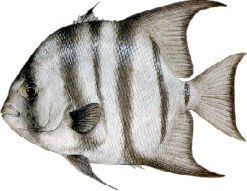
For me, the best fishing on the lake is at night from April to mid June.
I know this is a striper club, but during that period I’ve caught a lot of big bass, both largemouth and smallmouth. I’ve also caught a lot of white perch and some channel cats. This year I missed most of the spring night fishing season here at the lake. I did have a few good nights, but nothing like in past years. One reason was because of the weather. It seemed like the nights I wanted to go, a thunderstorm was threatening or it was very windy. That’s not to say I didn’t go fishing all that much. The reason I missed so much of the season here was because I spent so much time in southeast Virginia, on the Chesapeake Bay, fishing with my son-in-law and friends. We caught everything from tautogs to stripers to spadefish. We did manage to catch one cobia, about 60 lbs. I must admit though that the pound for pound strongest fish I ever fought was the spadefish. The pound for pound phrase is probably overused, but in the case of the spadefish, I think it’s true.
Spadefish look a little like an oversized angelfish, with black vertical stripes. In the Chesapeake Bay, spring is the prime season for spadefish. (Seems like all the good fishing happens at once.) During this period they like to hang around structure in large schools. The usual method when fishing for them is to use a float with a small hook and a split shot on the business end. The float is placed about 5 ft. above the hook. Just like bobber fishing in fresh water.
The preferred bait is a small piece of clam. Almost any type of tackle can be used except ultra light. I wouldn’t use light gear either, it’s hard enough to get them in with medium to heavy tackle.
When jellyfish arrive in the Bay, that usually signals the end of spadefish season. The spadefish spread out and gorge themselves on the jellyfish.
If you ever get the opportunity to go spadefishing, take it, you will not be disappointed. As one angler put it, “Spadefish are like bluegills on steroids”.
Good luck and keep the lines tight, Paul
I know this is a striper club, but during that period I’ve caught a lot of big bass, both largemouth and smallmouth. I’ve also caught a lot of white perch and some channel cats. This year I missed most of the spring night fishing season here at the lake. I did have a few good nights, but nothing like in past years. One reason was because of the weather. It seemed like the nights I wanted to go, a thunderstorm was threatening or it was very windy. That’s not to say I didn’t go fishing all that much. The reason I missed so much of the season here was because I spent so much time in southeast Virginia, on the Chesapeake Bay, fishing with my son-in-law and friends. We caught everything from tautogs to stripers to spadefish. We did manage to catch one cobia, about 60 lbs. I must admit though that the pound for pound strongest fish I ever fought was the spadefish. The pound for pound phrase is probably overused, but in the case of the spadefish, I think it’s true.
Spadefish look a little like an oversized angelfish, with black vertical stripes. In the Chesapeake Bay, spring is the prime season for spadefish. (Seems like all the good fishing happens at once.) During this period they like to hang around structure in large schools. The usual method when fishing for them is to use a float with a small hook and a split shot on the business end. The float is placed about 5 ft. above the hook. Just like bobber fishing in fresh water.
The preferred bait is a small piece of clam. Almost any type of tackle can be used except ultra light. I wouldn’t use light gear either, it’s hard enough to get them in with medium to heavy tackle.
When jellyfish arrive in the Bay, that usually signals the end of spadefish season. The spadefish spread out and gorge themselves on the jellyfish.
If you ever get the opportunity to go spadefishing, take it, you will not be disappointed. As one angler put it, “Spadefish are like bluegills on steroids”.
Good luck and keep the lines tight, Paul
 RSS Feed
RSS Feed